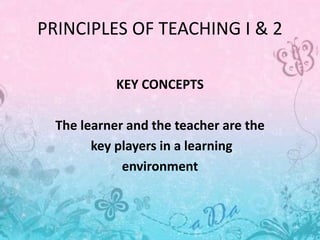
Principles of teaching i & 2
- 1. PRINCIPLES OF TEACHING I & 2 KEY CONCEPTS The learner and the teacher are the key players in a learning environment
- 2. The Learner • The learner is an embodied spirit. He is neither body nor spirit. • The learner has the power to see, hear, touch, smell and taste, perceive, imagine, retain, recall, recognize past mental acts, conceive ideas, make judgment, reason out, feel and choose.
- 3. Learners differ in their abilities, aptitudes, interests, home background, values and attitudes. The differences among learners become accentuated with the integration of children with special needs and children from indigenous peoples (IP) group in the classroom.
- 4. The teacher The professional teacher is the “licensed professional who possesse dignity and reputation with high moral values as well as technical and professional competence… s/he adheres to, observes, and practices a set of ethical and moral principles, standards and values.”
- 5. To facilitate learning, a teacher must: • Be an expert in her/his subject and skilled in the science and art of teaching; • Have a pleasing personality and a model of values; • Have passion for teaching sense of humor, patience and enthusiasm
- 6. The Learning Environment ….. consists of the physical, as well as the psychological environment, that surrounds the learner and that influences his/her learning. ….. that is clean, orderly, well-ventilated, well-lighted, spacious that allow movements, and free from unnecessary distractors is conducive to learning.
- 7. PRINCIPLES OF LEARNING “ The ability to learn is the most significant activity of man.” The process of learning is primarily controlled by the learner and not by the teacher. Students more readily internalize and implement concepts and ideas which are relevant to their needs and problems.
- 8. Activity Recall your experience with teacher . What in their personalities helped you make you learn? Which one did not help you learn at all? Share your reflection with your partner.
- 9. • Learning (behavioral change) is a consequence of experience. • Cooperative approaches as enabling. • Behavioral change requires time and patience. • Learning is sometimes a painful process. Behavioral change often calls for giving up the old and comfortable ways of believing , thinking, and valuing.
- 10. • In a day and age when so much emphasis is being placed upon instructional media, books, and speakers as resources for learning, we tend to overlook the richest source of all – the learner himself. • People are feeling as well as thinking beings and when their feelings and thoughts are in harmony learning is maximized. • Each person has his own unique styles of learning and solving problems. These styles may be effective or ineffective.
- 11. MANAGEMENT OF INSTRUCTION Guiding Principles in Determining and Formulating Learning Objectives 1. “Begin with and end in mind” – begin our lesson with a clearly defined lesson objective. 2. Share lesson objective with students – make your students won the lesson objective. 3. Lesson objectives must integrate objectives in the cognitive, psychomotor and affective domains for a wholistic lesson.
- 12. 4. Lessons objective must be connected to our student’s life experiences. 5. Lesson objective must be flow from the aims of education embodied in the Phil. Constitution and the vision-mission statements of the educational institution of which you are a part. 6. Aim at the development of critical and creative thinking. 7. For accountability of learning, lesson objectives must be SMART. (Specific, Measureable, Attainable, Result-oriented & Relevant, Time-bound & Terminal)
- 13. Selection and Organization of Content “There are dull teachers, dull textbooks, dull films, but no dull subjects.” Guiding Principles: 1. Teach content that: • is aligned with the goals and objectives of basic education curriculum. • responds to the needs of the learner • Includes cognitive skill and affective elements • fully and deeply covers the essentials to avoid the “mile-wide-and-inch-deep” impression.
- 14. 1. Validity 2. Significance 3. Balance 4. Self-sufficiency 5. Interest 6. Utility 7. Feasibility
- 15. • Teach the content that is of use to the learners; that is viable and feasible. • Facts are basic in the structure of cognitive subject matter. But content must go beyond facts. • Working out a process of conceptual understanding means teaching and learning beyond facts. This can be done by the use of the thematic or the integrated approach. • Subject matter content integrates the cognitive, skill and affective components.
- 16. • The cognitive content includes facts, concepts, principles, hypotheses, theories and laws. • The skill component dwells on thinking skills and manipulative skills. Thinking skills include: 1. Divergent thinking 2. Convergent 3. Problem solving 4. Metaphoric thinking 5. Critical thinking 6. Creative thinking
- 17. Divergent thinking includes: • Fluent thinking • Flexible thinking • Original thinking • Elaborative thinking Problem solving includes either: • Algorithmic or • Heuristic strategy
- 18. Critical thinking comes in varied forms: • Verbal reasoning • Argument analysis • Hypothesis testing • Decision making For creative thinking we must develop: awareness, curiosity, imagination, fluency, flexibility, originality, elaboration and perseverance
- 19. The affective component is concerned with values and attitudes. When we teach values, we connect facts, skills and concepts to the life of students. Values can be taught. They are both taught and caught.